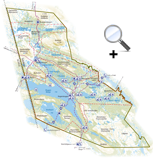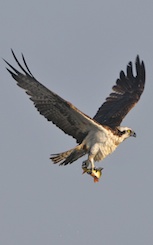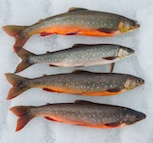 View over the southern part of the nature reserve. Photo: Marcus Elmerstad.
View over the southern part of the nature reserve. Photo: Marcus Elmerstad.
Rogen
The landscape around the large Lake Rogen has a character of its own, with enormous boulders, lichen-clad old pines and a maze of small lakes. Here you can walk or paddle for days without seeing clearings or roads.
Rogen moraine – ancient glacial maze
Rogen moraine consists of stones and gravel left behind by the inland ice in a network of ridges. Small lakes were often formed between the ridges. The seemingly countless lakes create a patchy and meandering blue pattern on the mountain map.
Rogen moraine is an internationally known concept among geologists. The landform also occurs in other parts of the world, but has been named after the area around Lake Rogen as this is the type location, described by early scientists.
Canoeing
Canoeing is a good way of exploring Rogen Nature Reserve in summer. It’s wonderful to glide along the shores of Lake Rogen, seeing all the boulders you would otherwise have to negotiate on land, or paddling from Käringsjön into a maze of small lakes. But it’s not an easy trip. The small jagged lakes are not connected, so you have to be prepared to carry your canoe, sometimes for several hundred metres. And the unpredictable weather can very quickly transform the waters of Lake Rogen into a real danger zone for canoeists.
Among giant pines, wolverine and black-throated diver
The barren moraine ground in a cold and dry climate is dominated by a few thick-skinned plants: pine, crowberry, cowberry and bilberry. And, of course, different species of lichens and mosses.
Even if the fauna may seem species-poor, the nature reserve is important for many endangered animals. Brown bear, wolverine and otter are some of the species found here, but the chances of seeing them are small. You’re much more likely to spot golden eagle, rough-legged buzzard or osprey soaring in the sky.
Black-throated diver is typical of this area. In summer evenings, its desolate call is often heard from the lakes. Before the autumn migration, large flocks gather on Lake Rogen.
Musk oxen – a small hairy herd
The entire Swedish musk oxen population, which in 2010 totalled seven animals, spends the winter months in the fells north of Lake Rogen. They eat hardly anything during winter, but live off their body fat. Their thick coats keep them warm. Musk oxen wool is the warmest wool in the world and can be up to 70 centimetres long.
If you meet a musk ox – stay calm and keep a distance of at least 100 metres. This is for their safety as well as your own! Musk oxen can charge if they feel threatened. If they are frightened and run away, a pregnant cow may lose her calf.
Fishing paradise
The small lakes and Lake Rogen all contain plenty of brown trout, charr, grayling, perch, pike and burbot. Lake Käringsjön is famous for its large graylings caught in summer and autumn. In winter, charr fishing in Lake Rogen and Lake Bredåsjön is an attraction.
Some lakes can have different pH-values and completely separate flora and fauna even if they are only a few hundred metres apart. A challenge for anglers, who may have to change bait between waters.
Thousand-year-old settlements
People lived in Gränslandet even in the Stone Age. They survived by fishing, trapping and hunting, and left many traces.
Many old settlements and graves were located in areas where tourists now rest or camp, which is no coincidence. Just like Stone Age people, today’s walkers look for beautiful places on flat ground, near water in a sheltered location.
From reindeer hunting to herding
Between lakes Rogen and Frösjön, east of the nature reserve, is a system of 150 well-preserved reindeer trapping pits. They date back to the time when reindeer were wild and hunted by people, but no one can say exactly how old they are. Today, Rogen Nature Reserve provides summer pasture for reindeer from Ruvhten Sijte Sami village, the second southernmost Sami village in Sweden.
Welcome to explore in Rogen!
Many people start their trip at Käringsjön. Here you can hire cottages, boats, and canoes and paddle straight out in the Rogen moraine maze. The mountain hut Rogenstugan run by the Swedish Tourist Association (STF) is a good starting point if you want to explore the large Lake Rogen. The hut is located on a promontory in the lake, where you can also hire a canoe and finish the day with a sauna and swim. Skedbrostugan is another attractive STA cottage, in a remote location in the interior of the reserve.
More information about the area can be found at Käringsjön and in Tännäs Fishing Centre. The Rogen information centre is found in the same building, outside Tännäs. Guided tours to the Tännäs musk oxen enclosure also start here.
Visitors are permitted to:
- go anywhere on foot or ski.
- pick common plants, berries and fungi for own use.
- temporarily overnight in tents.
- fish subject to regulations.
- drive snowmobiles on the marked snowmobile trail and on ice to access fishing sites on Lake Bredåsjön and southeast of the snowmobile trail on Lake Rogen, until 19 April
- cautiously light a fire with dry branches, or your own logs, but note that special regulations apply within marked area.
Visitors are not permitted to:
- damage land or vegetation.
- disturb animals or birds, dig up plants or remove mosses or lichens.
- damage living trees, dead trees or fallen tree trunks.
- drive snowmobiles outside snowmobile trail or on lakes Bredåsjön and Rogen south of the snowmobile trails.
- drive other motor vehicles on land, ice or water (also applies to boats with electric engines).
- travel by canoe or boat within the area marked on the map.
- use fuel-driven ice drills.
- light fires within area marked on the map, except in prepared fireplaces using wood that has been supplied.
- approach musk oxen closer than 100 metres.
- bring dogs during the period 20 April to 31 May, other than on winter trails and to access permitted fishing waters.
Full regulations are available here »
There are also other laws and regulations to consider.
The purpose of the protection is
- to preserve for the future a distinct mountain area that is probably unique in the Swedish alpine landscape.
- to ensure that visits by the public do not impair the natural assets in the area.
Brief facts
Year: Established in 1976
Name: Rogen Nature Reserve
Land area: 402 square kilometres
Water area: 85 square kilometres
Municipality: Härjedalen
County: Jämtland
Land owner: Private and public land
Nature conservation manager: Jämtland County Administrative Board.












